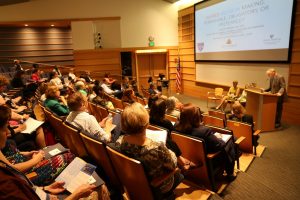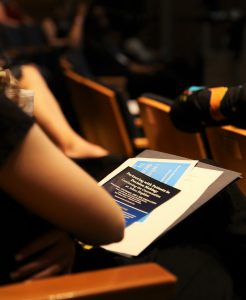The atmosphere in the Albert H. Owens Jr. Auditorium in the David H. Koch Cancer Research Building was buzzing with conversation and an intellectual energy. More tha 100 people, ranging from nurses and physicians to administrators and patients who came as far as Brazil and as close as the hospital next door, were gathered for the Partnering with Patients in Decision-Making: Continuing the Conversation at Johns Hopkins inaugural conference on shared decision-making.

There has been a pendulum swing of health care from paternalism — the doctor tells you what to do — to patient’s choice — the doctor lays out all the options, including pros and cons, and expects you to decide on your own. Yet neither forms of health care practice take advantage of the unique opportunity for the physician, an expert in clinical evidence, and the patient, an expert in his or her experiences and values, to work together to come up with the best decision possible. Neither takes advantage of what shared decision-making is capable of.
Shared decision-making, according to the Informed Medical Decisions Foundation, is defined as “a collaborative process that allows patients and their providers to make health care decisions together … [and] takes into account the best clinical evidence available, as well as the patient’s values and preferences.”
Zackary Berger, a general internist and bioethicist whose passion drove him to create this daylong conference, chuckles at how shared decision-making is still this vague “term that is agreed by all to be good, like mom and apple pie.”
Embracing a well-meaning generality may have been fine for some time, but in 2015, the stakes were raised. It was during that year that the Centers for Medicare and Medicaid Services required shared decision-making for reimbursement in scenarios such as common screening techniques for lung cancer. Having no agreed-upon definition for this term suddenly posed real-life consequences for physicians and patients alike.

As a member of the planning committee for the conference, I was incredibly lucky to have the chance to work with Berger. Through multiple panel sessions and a 20-plus poster exhibit, the planning committee created an opportunity for conference participants to discuss the concept of shared decision-making and its facilitators, barriers and relationship to racial, socioeconomic and health care disparities, especially in our hometown of Baltimore. Notable attendees included the unabashedly honest and down-to-earth patient advocate Casey Quinlan, as well as the two keynote speakers, former drug dealer turned poet and professor D. Watkins and Larry Allen, a cardiologist and heart failure specialist from the University of Colorado.
Although the gathering did not come up with a master plan to make shared decision-making a fixture at Johns Hopkins (yet!), I left the conference with hope that an acknowledgement of implicit biases and continued efforts to honor the patient perspective would be the sparks to change our health care system.
If you are interested in learning more about the conversation of shared decision-making at Johns Hopkins, feel free to join a brainstorming session on Sept. 7, 2016, at the Hampton House at 624 N. Broadway, room 688, from noon to 1 p.m. All are welcome!